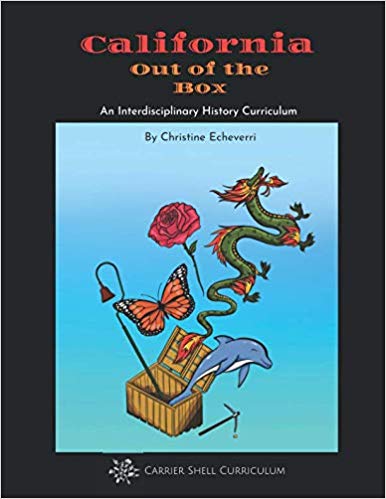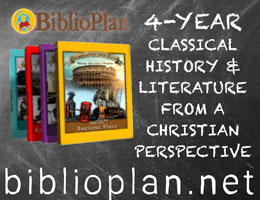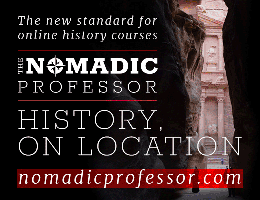California Out of the Box: An Interdisciplinary History Curriculum takes a unit study approach to the study of California history, incorporating geography, science, language arts, and critical thinking. While the curriculum covers the California State Standards for fourth grade (up through the 1930s) it can be used with grades three through six. Coverage of history is sufficient for one school year, but other subject areas are not covered sufficiently for a full year’s credit.
A parent or teacher will present the course from this 301-page book along with eight additional required books. Stories from Where We Live: California Coast and the National Audubon Society Field Guide to California are both used throughout the study. The other six books used in each of the course’s six units are Island of the Blue Dolphins, Valley of the Moon: The Diary of Maria Rosalia de Milagros, A Gift for Abuelita, By the Great Horn Spoon!, The Earth Dragon Awakes, and Esperanza Rising. (Stories from Where We Live: California Coast has gone out of print, so Carrier Shell Curriculum has received permission to reprint most of the stories in two volumes which they sell as the Stories Combo Set. The two volumes are titled The California Coast reader [spiral-bound] and California Out of the Box Supplement [paperback].)
More books are suggested for each unit but are not required. For families with younger students participating in the study, there is a list of suggested picture books that might be used along with each unit.
The historical fiction books serve as the anchors for the study, providing students with context for learning aspects of California history. Like many unit studies, California Out of the Box offers opportunities for lots of hands-on activities, including choices to suit different types of learners.
Instructions at the front of the book explain how to prepare a three-brad pocket folder for each student. Handouts in the appendices are to be copied, punched with holes, and placed in the folder. Families are given permission to copy these pages for family members, but schools or co-ops need to purchase a class license. Alternatively, you can purchase the California Out of the Box Student Folder book, which has all the handouts for the curriculum.
Course author, Christine Echeverri, believes that effective learning includes taking children to deeper levels of thinking. She introduces sections of the reading with what she calls “big questions” that correlate with themes of the books. Examples of these “big questions” are: “What can myths teach us?” and “How are humans and animals connected?” (both on page 27), and “Why is history worth knowing?” (on page 57). “Reflections” are yet another avenue for student responses. Reflections might be a single question or activity or a series of questions and activities that involve discussion, writing, and drawing. Many of the questions and reflections help students think through the “big questions.” She also has the expected comprehension, discussion, and review questions.
Projects are included as well. Some projects are to be completed by all students. For example, during the study of Island of the Blue Dolphins, all students will create a collection of leaves, plants, and flowers and learn how to identify them with the Audubon Guide. Sometimes students choose from a number of project options such as in the study of By the Great Horn Spoon! where students can choose one or two of the five suggested projects. Each of those projects has multiple parts. For instance, the music project on page 111 begins with a discussion of words used in the story in relation to gold. Students then become familiar with the song “Oh Susanna!” A discussion of the song’s lyrics follows this. The culminating activity for the project is for the student to write two verses of their own to add to “Oh Susanna!” On page 114, another project for this same lesson begins with a discussion and some internet research, then students use recycled materials to create a model of a mining camp.
The course occasionally presents research activities that direct students to specific internet sites. Some research activities are brief with no written response, but some have students take notes and make sketches in a sketchbook to document their research.
Timeline activities are included throughout the course. As the author explains, these can be done in a low-tech fashion with note cards or in a high-tech fashion using the free online site Timetoast.
Science is covered through nature observation and activities as students study topics such as geology, weather, and habitats. Geography is taught through reading, discussion, internet research, and map work. Under language arts, students cover literature, vocabulary, composition, and research. Critical thinking is developed by the questions and discussions.
Parents or teachers should choose what types of responses and activities to require from students, depending upon their age and ability. For instance, an older student might write a multi-paragraph summary while a young student might give a brief oral narration. “End of Unit” questions are designed for fifth and sixth graders for additional discussion, writing, or projects. Some questions and activities have predictable answers, so an answer key is provided in an appendix.
Religious beliefs, the California missions, and Catholicism (all in relation to California) are discussed, but the presentation is secular—it does not promote any religious point of view.
The book is available in your choice of spiral-bound, perfect-bound, and PDF formats. Since the interior pages are printed in black and white, and you will need to copy a number of these for students, I would suggest the digital download for most situations. But if you think you want to print out the pages from which you will teach as well, a printed copy might be more practical since there about 300 pages.
California Out of the Box: An Interdisciplinary History Curriculum should appeal to those who want a program that is adaptable for students of different ages and abilities. This course can simultaneously be challenging for sixth graders and accessible for third graders. The interdisciplinary approach based on historical fiction also promises to be a more interesting option than a traditional textbook.












